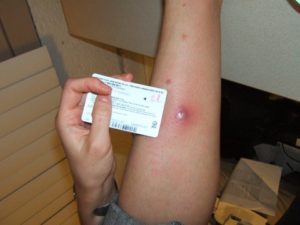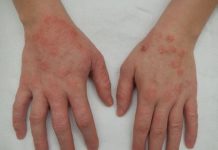
By Maggie Marshall and Cheyenne Reynolds; Farnsley Middle School (Louisville, Ky)
“It all started when Maggie was around 6 months old. She was always crying or sleeping; usually she was crying,” says Billie Marshall, Maggie’s mother. “Whenever she had a ‘flare up’ she would get small red bumps/spots. It would usually only be one or two spots. We didn’t really know how to act, we didn’t know what it was. We think she got it from her grandmother since she was a nurse at a hospital.”
Maggie’s parents found out she had MRSA because one day they took her to the family pediatrician because they thought she had a cold. After they found that out, Maggie’s parents started taking her to that doctor and they prescribed her stronger antibiotics. Her MRSA flare ups finally ended when she was around 2 years old.
Methicillin-resistant Staphylococcus aureus (MRSA) is an infection that can be mild, but it can evolve to be very deadly! According to WebMD, MRSA is bacterium that causes infections in many parts of the body. It is resistant to most antibiotics, so it makes it very difficult to treat. MRSA makes small red bumps on the skin that may irritate, depending on how bad the infection is. It usually affects only young people or older people because they have lower immune systems which makes them more susceptible to infection.
The Centers for Disease Control and Prevention (CDC) talks about MRSA being the cause of most skin infections. Sometimes it can cause pneumonia and other problems. You can get sepsis (a life-threatening reaction to severe infection in the body) if the MRSA infection is left untreated.
The CDC did a study that shows one in three people carry staph MRSA in their nose, but it usually doesn’t carry the illness. The amount of MRSA infections in healthcare facilities are declining. Between 2005 and 2011, invasive MRSA infections that began in hospitals declined 54%, with 30,800 fewer severe MRSA infections. Also, the study showed there were 9,000 fewer deaths from MRSA in hospital patients in 2011 versus in 2005.
National Center for Biology Information (NCBI) says that MRSA can be community-associated MRSA (CA-MRSA) and hospital acquired MRSA (HA-MRSA). “You can get CA-MRSA from touching another person that has it on their skin. Someone can get HA-MRSA from being in a hospital or a healthcare facility.”
CA-MRSA can cause infections on the skin that might look like a pimple/boil. “If the infection is left untreated it may develop into serious, life-threatening issues such as infections in the bloodstream, bones, joints, or lungs. Although it is less likely, you can get MRSA in other parts of the body like lungs, bloods, eyes, and urine,” says Medicine Net.
Medicine Net says MRSA has many different symptoms for the different types. “Symptoms of MRSA are: large, red, painful bumps under the skin (boils), small sores that look and feel like spider bites.” The boils/pimples that form are normally hot and filled with pus. “More symptoms are: headache, generally feeling sick, muscle aches, shortness of breath, fatigue fever, shivering, coughing, and chest pain.”
Medicine Net states “Since the 1960s, MRSA has picked up more resistance to different antibiotics. Overuse of antibiotics has increased resistance in MRSA and other infectious bacteria, because resistance genes (the genes that code for resistance) can be passed from bacteria to bacteria.”
According to Mayo Clinic, since MRSA is an infection that is very resistant, it is hard to treat it. Usually, doctors will prescribe antibiotics that will control the infection. Since it’s so hard to get rid of it you have to keep your skin very clean. The boils/pimples will look like they need to be popped, but do not squeeze, poke, or pop the boil. If you pop it the pus inside will spread and make more boils/pimples to form.
To prevent from getting MRSA Mayo Clinic says “Wash your hands. Careful hand washing remains your best defense against germs. Scrub hands briskly for at least 15 seconds, then dry them with a disposable towel and use another towel to turn off the faucet.” For extra cleanliness you could carry a small bottle of hand sanitizer that has at least 62% alcohol for times when you don’t have access to soap and water. You would also want to keep wounds covered, keep cuts and wounds clean and covered with dry bandages until they heal. The pus from infected sores may contain MRSA, and keeping wounds covered will help prevent the infection from spreading.
Indiana University of Pennsylvania says you would also want to keep personal items personal for example, avoid sharing personal items such as towels, sheets, razors, clothing and athletic equipment. “MRSA spreads on contaminated objects as well as through direct contact.” Always shower after athletic games or practices. “Shower immediately after each game or practice. Use soap and water. Don’t share towels. Sanitize linens.” If you have a cut or sore, wash towels and bed sheets in a washing machine set to the hottest water setting (with added bleach, if possible) and dry them in a hot dryer. Wash gym and athletic clothes after you wear them.
It’s been about 11 years since Maggie last had a flare up and MRSA has not affected her since then. “I’m glad the flare ups ended when they did, I would hate to still be struggling with that infection,” says Maggie.

This work is licensed under a Creative Commons Attribution-NonCommercial-NoDerivs 3.0 Unported License.














